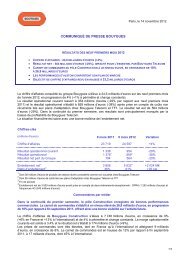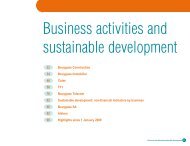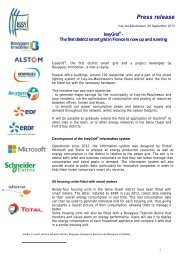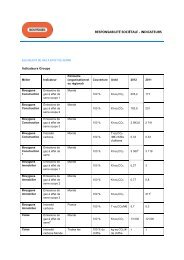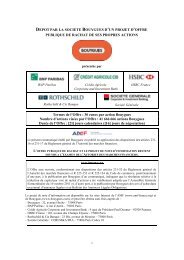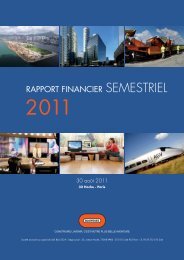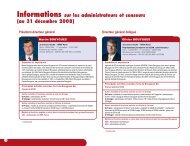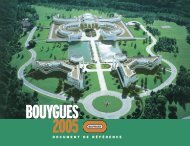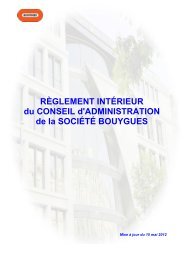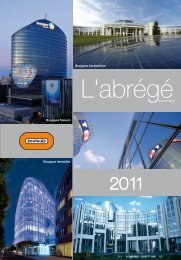A N N U A L R E P O R T - Bouygues
A N N U A L R E P O R T - Bouygues
A N N U A L R E P O R T - Bouygues
Create successful ePaper yourself
Turn your PDF publications into a flip-book with our unique Google optimized e-Paper software.
Services carried out on behalf of content providers<br />
in relation to SMS+ services, special<br />
numbers and i-mode services are not included<br />
in income and expenses for the period. Only the<br />
margin on such services is recognised in sales.<br />
• Handset sales<br />
Handset sales are recognised on the sale of the<br />
handset to the distributor or retailer, but the<br />
margin on the sale is eliminated until the line is<br />
activated by the consumer.<br />
• Distributor / retailer commission<br />
All commission payable to distributors and retailers<br />
is recognised as an expense.<br />
2.12.2. Accounting for long-term<br />
contracts<br />
■ Construction activities<br />
In all the Group’s construction activities, longterm<br />
contracts are accounted for using the<br />
percentage of completion method. The revenue<br />
recognised equals the latest estimate of the<br />
total selling price of the contract multiplied by<br />
the actual stage of completion determined by<br />
reference to the physical state of progress of the<br />
construction work.<br />
If a contract is expected to generate a loss on<br />
completion, a provision for losses to completion<br />
is recognised as a current provision in the balance<br />
sheet. The loss is provided for in full as soon<br />
as it can be reliably measured, irrespective of the<br />
stage of completion.<br />
■ Property development<br />
The accounting treatment applied to property<br />
development activities is as follows:<br />
Property development revenues are recognised<br />
using the percentage of completion method once<br />
the following conditions have been met:<br />
- building permit with no appeal;<br />
- signature of notarised deed of sale or development<br />
contract;<br />
- construction contract signed (order given to<br />
start works).<br />
The percentage of completion represents costs<br />
incurred to date as a proportion of the total<br />
estimated costs to completion.<br />
Property development project finishing costs are<br />
recognised on a percentage of completion basis.<br />
All interest charges associated with ongoing or<br />
completed property development projects are<br />
expensed as incurred.<br />
2.12.3. Profits / losses from joint<br />
operations<br />
These represent the Group’s share of profits<br />
or losses from non-consolidated companies<br />
involved in the operation of production sites<br />
for road-building and asphalt products, and are<br />
included in operating profit.<br />
2.12.4. Share-based payment<br />
In accordance with IFRS 2, stock subscription<br />
options granted to corporate officers or employees<br />
of <strong>Bouygues</strong> or other Group companies (TF1)<br />
are accounted for in the financial statements<br />
as follows: the fair value of the options granted<br />
(corresponding to the fair value of the services<br />
rendered by the employees as consideration<br />
for the options) is recognised as an employee<br />
benefit under “Personnel costs” in the income<br />
statement, with the matching entry credited to<br />
shareholders’ equity.<br />
The amount of the employee benefit is measured<br />
at the grant date of the option using the<br />
Black & Scholes model, and is charged to the<br />
income statement over the vesting period of the<br />
rights. In accordance with IFRS 2, this treatment<br />
applies only to plans awarded after 7 November<br />
2002.<br />
2.13. Cash flow statement<br />
The cash flow statement is presented in accordance<br />
with IAS 7 and CNC recommendation 2004-<br />
R-02.<br />
This statement explains changes in the Group’s<br />
net cash position, which is defined as the net<br />
total of the following balance sheet items:<br />
- cash and equivalents;<br />
- overdrafts and short-term bank borrowings.<br />
2.14. Off balance sheet<br />
commitments<br />
A summary of contractual obligations and commercial<br />
commitments is provided in Note 19.<br />
2.15. Financial indicators<br />
Definitions of key financial indicators:<br />
2.15.1. EBITDA<br />
Current operating profit excluding net depreciation<br />
and amortisation expense and changes<br />
in provisions.<br />
2.15.2. Free cash flow<br />
Cash flow (from operations, before changes in<br />
working capital) less net capital expenditure for<br />
the period.<br />
2.15.3. Net debt<br />
This represents the aggregate of:<br />
• cash and equivalents;<br />
• overdrafts and short-term bank borrowings;<br />
• non-current and current debt;<br />
• financial instruments (used to hedge financial<br />
liabilities measured at fair value).<br />
2.16. Other information<br />
Comparability of the IFRS financial statements:<br />
• The accounting policies applied under IFRS as<br />
at 31 December 2004 are the same as those<br />
applied as at 31 December 2005, and consequently<br />
there is no impairment of the comparability<br />
of balance sheet, income statement and<br />
cash flow statement items between accounting<br />
periods.<br />
• In accordance with IFRS 5, the TF1 subsidiary<br />
TPS, which is in process of divestment, is shown<br />
on the separate lines used to report held-forsale<br />
assets and operations in the consolidated<br />
balance sheet as at 31 December 2005 and the<br />
income statement for the year then ended (see<br />
Note 24).<br />
• The impact of changes in the scope of consolidation<br />
during 2005 does not affect the<br />
comparability of the financial statements as<br />
presented.<br />
CONSOLIDATED FINANCIAL STATEMENTS<br />
165



